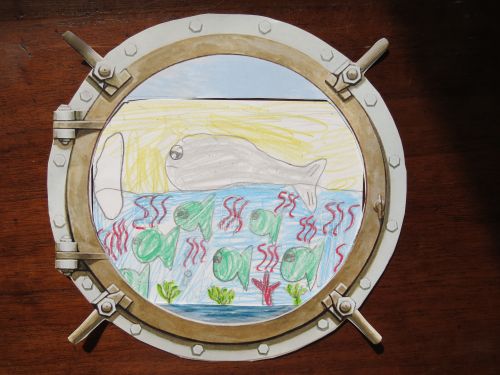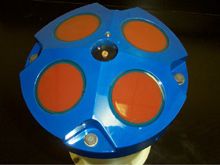Through the Porthole: What instruments do oceanographers use in the field to collect data?

Part I: The acoustic Doppler current profiler
The acoustic Doppler current profiler (ADCP) is an instrument that measures the ocean current speed and direction throughout the water column using the Doppler effect. On the R/V Ukpik the ADCP is mounted on a BioSonic towing body (like a very heavy sled) and towed alongside the vessel at approximately 5 knots.


Not sure of what the Doppler effect is? You experience the Doppler effect anytime you go driving and pass another vehicle, however the effect is especially evident when an ambulance approaches, and passes you with its siren on. As it zooms past and continues down the street you’ve probably noticed that the siren sounds changes to a lower pitch. This is a classic example of the Doppler effect. For a quick audio example, click on the video:
http://,
You only hear the true sound, or the sound the ambulance driver actually hears, for the exact moment that the ambulance is right next to you. Think about it. As an ambulance approaches, the sound waves get pushed together and hit our eardrums more frequently than if it were standing still. This increase in frequency results in a higher pitch. As the ambulance heads away from you the sound waves stretch apart and hit our eardrum less frequently, which results in a lower pitch. I like to think of the Doppler effect as a magic trick! Magic is all about illusion and perception of what you see and hear, not what’s really happening. In the case of the Doppler effect the source’s sound never actually changes. The change perceived is due to the relative motion between the source and the receiving object, which in the case of the ambulance is you!
Specifically the ADCP transmits continuous high frequency sound waves, called chirps or pings. As the chirps from the instrument travel they bounce off of particles suspended in the water column and are reflected back to the instrument. Particles moving toward the instrument result in higher frequency waves reflecting back to the ADCP. The difference between the frequency of the outgoing and incoming waves the ADCP receives is called the Doppler Shift. Researchers can use data from the ADCP to measure the velocity (speed and direction) of particles as well as the relative type of organisms that are in the water column. Organism identification is, in part, based on the different frequency signature of each organism and the location in, and movement patterns through the water column.
If you’d like to know more about the ADCP go to: http://oceanexplorer.noaa.gov/technology/tools/acoust_doppler/acoust_doppler.html
If you’re interested in additional information about the Doppler Shift and how scientists measure distant stars and galaxies using light wave frequencies, just click on the following video. It starts out a little strange, but then ends with a great example and explanation of the Doppler Shift! http:// http://ed.ted.com/on/q8FeukzZ
A través de la ventanilla: Cuales instrumentos usan los oceanógrafos en el campo de estudios para coleccionar data?

Parte I: El perfilador de corrientes acústico Doppler
El perfilador de corrientes acústico Doppler (ADCP) es un instrumento que mide la velocidad y dirección de la corriente oceánica a través de la columna de agua usando el efecto de Doppler. En la R/V Ukpik el ADCP es montado sobre un cuerpo de arrastre BioSonic (como un trineo de carga pesada) y arrastrado al lado de la nave a mas o menos 5 nudos.


Inseguros de lo que es el efecto Doppler? Tienen la experiencia del efecto Doppler cada vez que van a manejar y pasan a otro vehículo, sin embargo el efecto es especialmente evidente cuando se aproxima una ambulancia, y te pasa con la sirena prendida. A lo que pasa y continua a lo largo de la carretea probablemente han notado que el sonido de la sirena cambia a un tono más bajo. Este es el ejemplo clásico del efecto Doppler. Para un ejemplo de audio, hagan click en el video:
http://,
Solo escuchan el sonido verdadero, o el sonido que el chofer de la ambulancia escucha, en el momento exacto en que la ambulancia está al lado tuyo. Piense acerca de eso. A lo que se aproxima la ambulancia, las ondas de sonido se juntan y chocan con nuestros oídos con más frecuencia de lo que sería si estuviéramos parados en un sitio. Este incremento en frecuencia resulta en un tono más alto. A lo que se aleja la ambulancia las ondas de sonido se distancian y chocan con nuestros oídos con menos frecuencia, que resulta en un tono más bajo. Me gusta pensar del efecto Doppler como un truco mágico. Magia es acerca de ilusión y percepción de lo que escuchas y ves, no de lo que está ocurriendo en realidad. En el caso del efecto Doppler, la fuente del sonido en realidad nunca cambia. El cambio percibido es el resultado de la moción relativa de la fuente y del receptor, que en el caso del a ambulancia eres tú!
Específicamente el ADCP transmite ondas continuas de alta frecuencia, llamadas chirps o pings. A lo que los chirps del instrumento viajan estos rebotan de partículas suspendidas en la columna de agua y son reflexionados de regreso al instrumento. Partículas viajando rumbo al instrumento resultan en ondas de frecuencia más altas que reflexionan de regreso al ADCP. La diferencia entre las frecuencias de las ondas de ida con las ondas de regreso que el ADCP recibe es llamado el cambio Doppler (Doppler shift). Investigadores pueden usar los datos del ADCP para medir la velocidad (velocidad y dirección) de partículas al igual que el tipo relativo de organismos que están en la columna de agua. Identificación de organismos, en parte, es basada en las diferentes firmas de frecuencia de cada organismo y el lugar y patrón de movimiento a través de la columna de agua.
Si quieren saber más acerca del ADCP vayan al:
http://oceanexplorer.noaa.gov/technology/tools/acoust_doppler/acoust_doppler.html
Si están interesados en información adicional acerca del Cambio Doppler y como científicos miden estrellas y galaxias distantes usando frecuencias de ondas de luz, simplemente hagan click en el siguiente video. Empieza un poco raro, pero termina con un gran ejemplo y explicación del Cambio Doppler!
http://


Comments